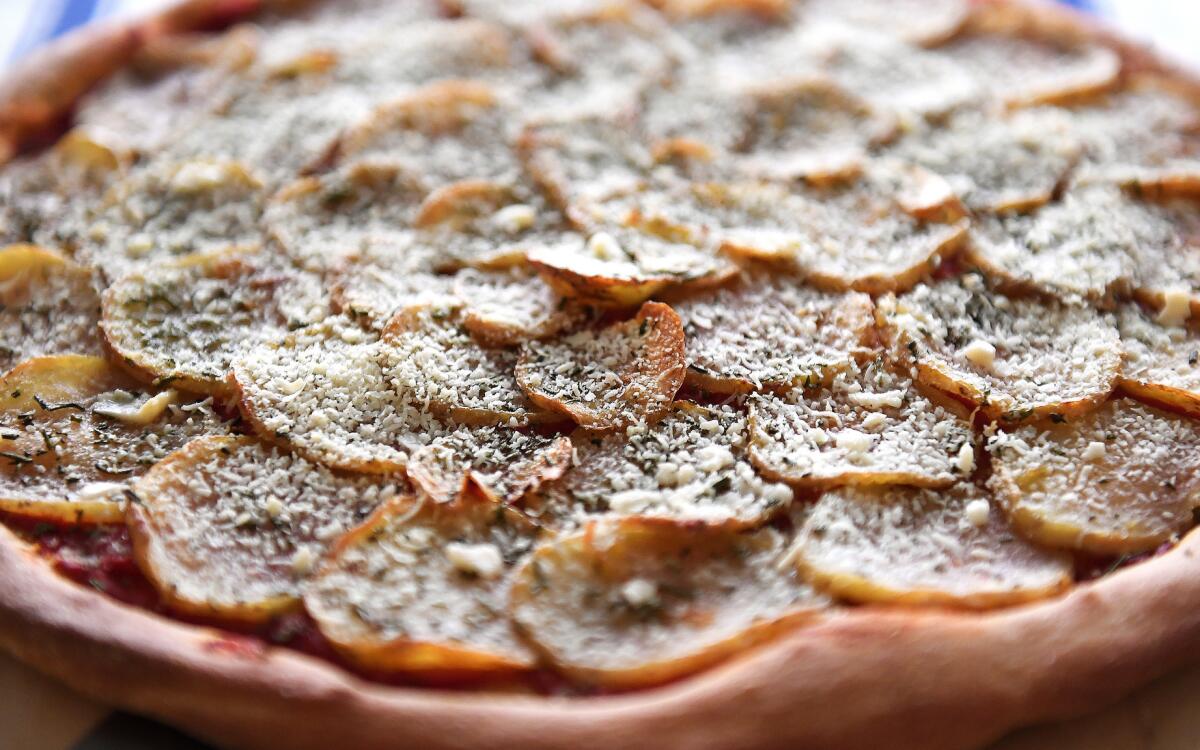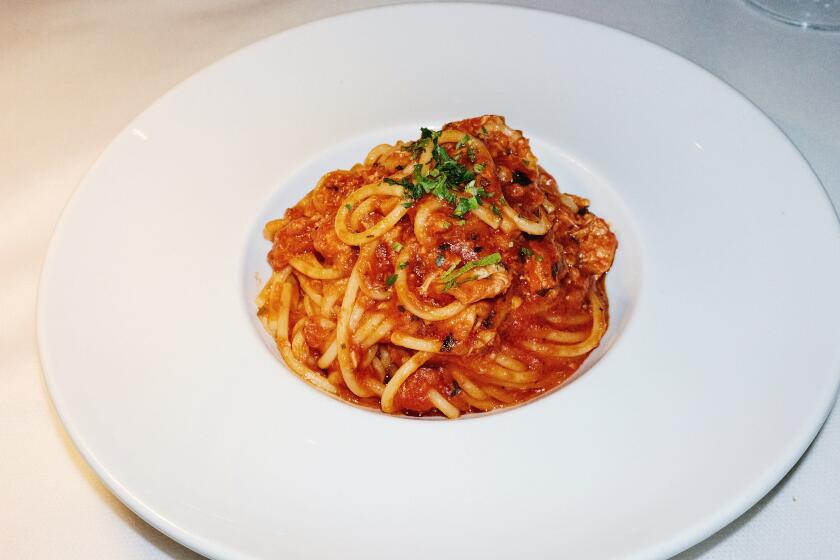Pizza with Roasted Potatoes

- Share via
Pasta is the last place most of us would think to look for potatoes — and I don’t consider gnocchi a pasta. But they play key roles in some of my favorite Italian dishes. Diced potatoes and trenette, a narrow ribbon pasta, are tossed with pesto in a signature dish from Liguria, Italy; and potatoes appear with cabbage, kale, leeks and buckwheat pasta in a hearty dish from Lombardy.
These dishes are decidedly pastas — not potato dishes — with just enough potatoes to provide a surprising contrast of textures. In the Ligurian dish, the pesto coats the trenette and sinks into the potatoes. Green beans contribute additional life and color. When I make this dish, I sometimes stray from tradition and substitute strozzapreti, a thick, chewy pasta that looks like a twisted towel (the world means “priest stranger”) for the trenette. You are more likely to find strozzapreti in the southern region of Apulia, Italy, than in Liguria. The green beans and the strozzapreti are about the same size, and they make a pretty combination with a winning contrast of textures.
In Lombardy, a rich peasant dish is made with buckwheat pasta called pizzoccheri, cabbage, greens, potatoes, leeks and abundant butter and cheese. Italians tend to cook all the vegetables, and the pasta, in the same pot, then toss everything with a great deal of Fontina and butter. I cook the vegetables separate; I boil the potatoes and blanch the greens and cabbage in a large pot of salted water that I will also use for the pasta. Then I soften leeks with garlic and sage in a mixture of olive oil and butter in a wide skillet, add the kale, cabbage and potatoes to the pan, and let the vegetables cook together for a few minutes. I cook my pasta and use some of the starchy cooking water as a sauce for the vegetables. Authentic pizzoccheri is not easy to come by, so you can substitute with Japanese soba noodles or whole wheat pasta made with local California wheat.
I first came across pizza topped with potatoes years ago in Rome, at a hole-in-the-wall stand where long, rectangular pies with dozens of toppings emerged from large ovens. One of the pizzas was topped with thinly sliced potatoes sprinkled with rosemary, spread in one layer over a film of tomato sauce. I wondered if the potatoes would weigh down the pizza, but they did not, and the combination of flavors and textures was heavenly. It was the first new pizza I tried to replicate when I returned to Los Angeles.
When I make pasta and potato dishes in California, I use fingerlings, which are easy to find in farmers markets and supermarkets. They have a wonderful nutty flavor and absorb the perfect amount of sauce. They’re starchier than a boiling potato but not as starchy as an Idaho, so they stay intact when you slice them. Yukon golds are similar in texture and can be substituted.
When it comes to potato choices for pizzas, russets can be too starchy. I use medium-size potatoes — red or white boiling or Yukon golds — sliced thin, tossed with olive oil, salt and pepper, and roasted in a 425-degree oven until tender. When I’m ready to assemble my pizza, I roll out a thin crust, brush it with olive oil and top it with a thin layer of marinara sauce or crushed tomatoes seasoned with garlic and salt. One pound of sliced roasted potatoes makes a perfect layer on top of the tomato sauce. I sprinkle the potatoes with a generous amount of chopped fresh rosemary and bake the pizza in a hot oven. The pizza gets some Parmesan as well, added during the last five to eight minutes of baking.
The surprising combination of ingredients makes terrific cold weather meals — especially the pizzoccheri. Who doesn’t like to eat warm, simple comfort food on a rainy winter day?
Pizza dough
Three to four hours before you wish to make the pizza, prepare the dough. In the bowl of a stand mixer, or a large bread bowl, dissolve the yeast in the water. Add the sugar and stir together. Let sit a minute or two, until the water is cloudy. Stir in the olive oil.
If you’re using a stand mixer, combine the flour and salt and add to the yeast mixture all at once. Mix together the dough using the paddle attachment, then switch to the dough hook. Knead at low speed at first for about two minutes, then increase the speed and continue to knead until the dough comes away cleanly from the sides of the bowl, about 5 minutes. (Hold the machine down if it starts bouncing around.) Turn out onto a flour-dusted work surface and knead by hand until the dough is smooth and firm, about 1 minute. (If making the dough by hand, combine the flour and salt, then stir the flour into the yeast mixture, 1 cup at a time. As soon as you can scrape the dough into one piece, turn it out onto a lightly floured work surface and knead until the dough is smooth, 8 to 10 minutes.)
Transfer the dough to a clean, lightly oiled bowl. Cover bowl tightly with plastic wrap, and leave it in a warm spot to rise until just about doubled in bulk, 2 to 3 hours. When it is ready, the dough will stretch as it is gently pulled.
Pizza
Heat the oven to 425 degrees and insert a pizza stone to heat. Line a baking sheet with parchment.
Place the sliced potatoes in a bowl and add 2 tablespoons olive oil, tossing the potatoes until they are evenly coated. Add ½ teaspoon salt and several grinds of pepper, or to taste. Spread the potatoes in a single layer on the baking sheet.
Roast the potatoes until tender, about 15 minutes. Remove and increase the oven temperature to 450 degrees.
Remove the dough from the oiled bowl and shape it into a ball: Gently pull down the sides of the dough and tuck them under the dough, working around the dough 4 to 5 times to form a ball. On a smooth, unfloured surface, roll the ball under your palm until it is smooth and firm. Place the ball onto a lightly oiled baking sheet, cover with plastic wrap, and set aside for 15 to 20 minutes to give the ball a chance to relax.
Oil a 14-inch pizza pan or similarly sized baking sheet. Add the dough and slowly press it out to a circle that is 12 to 14 inches in diameter. (As you work the dough, it will get tight and start to spring back. When this happens, set it aside to rest for a few minutes, then continue until it is fully stretched out.) Using your fingers, form a slightly thicker raised rim around the edge of the circle. Brush everything but the rim with a little olive oil.
Spread the marinara sauce evenly over the top of the dough, using a small offset spatula or a rubber spatula. Arrange the potato slices on top, overlapping slightly. Sprinkle with rosemary and drizzle over 1 tablespoon olive oil.
Place the pizza pan on the stone in the hot oven. Bake 12 minutes. Sprinkle over the cheese and return to the oven until the cheese has melted and begun to color slightly, 5 to 8 minutes. Remove from the oven and serve. The pizza can also be served warm or at room temperature.
Get our Cooking newsletter.
Your roundup of inspiring recipes and kitchen tricks.
You may occasionally receive promotional content from the Los Angeles Times.















